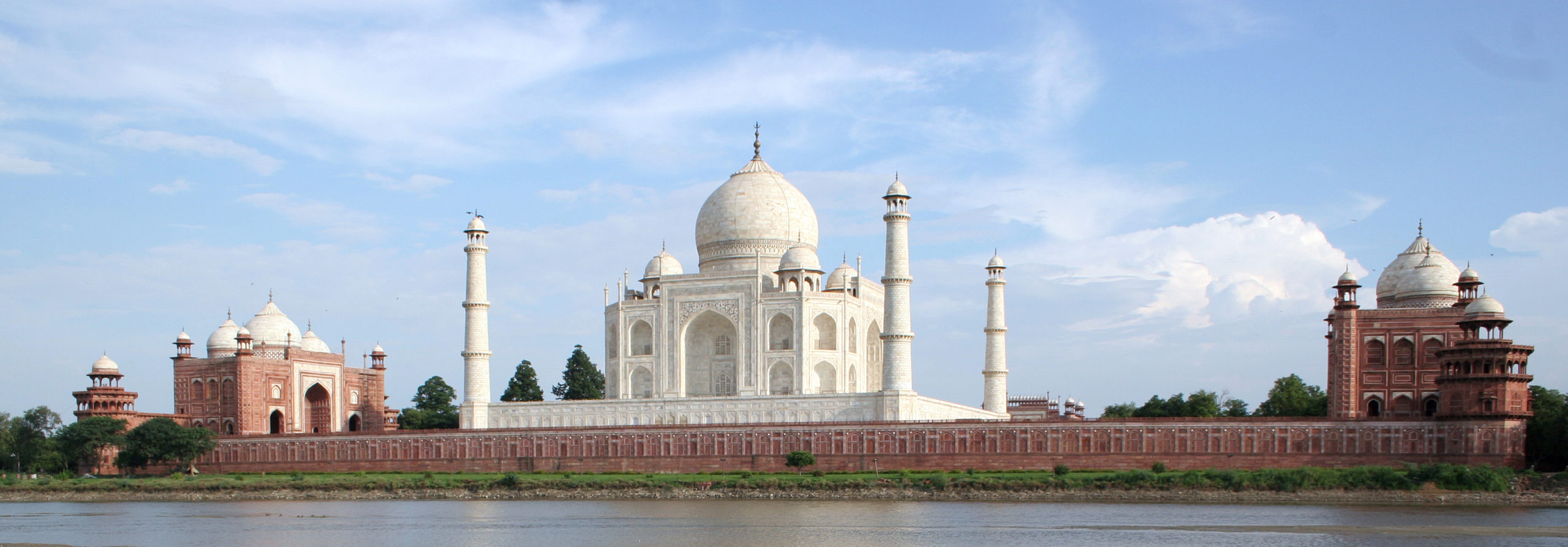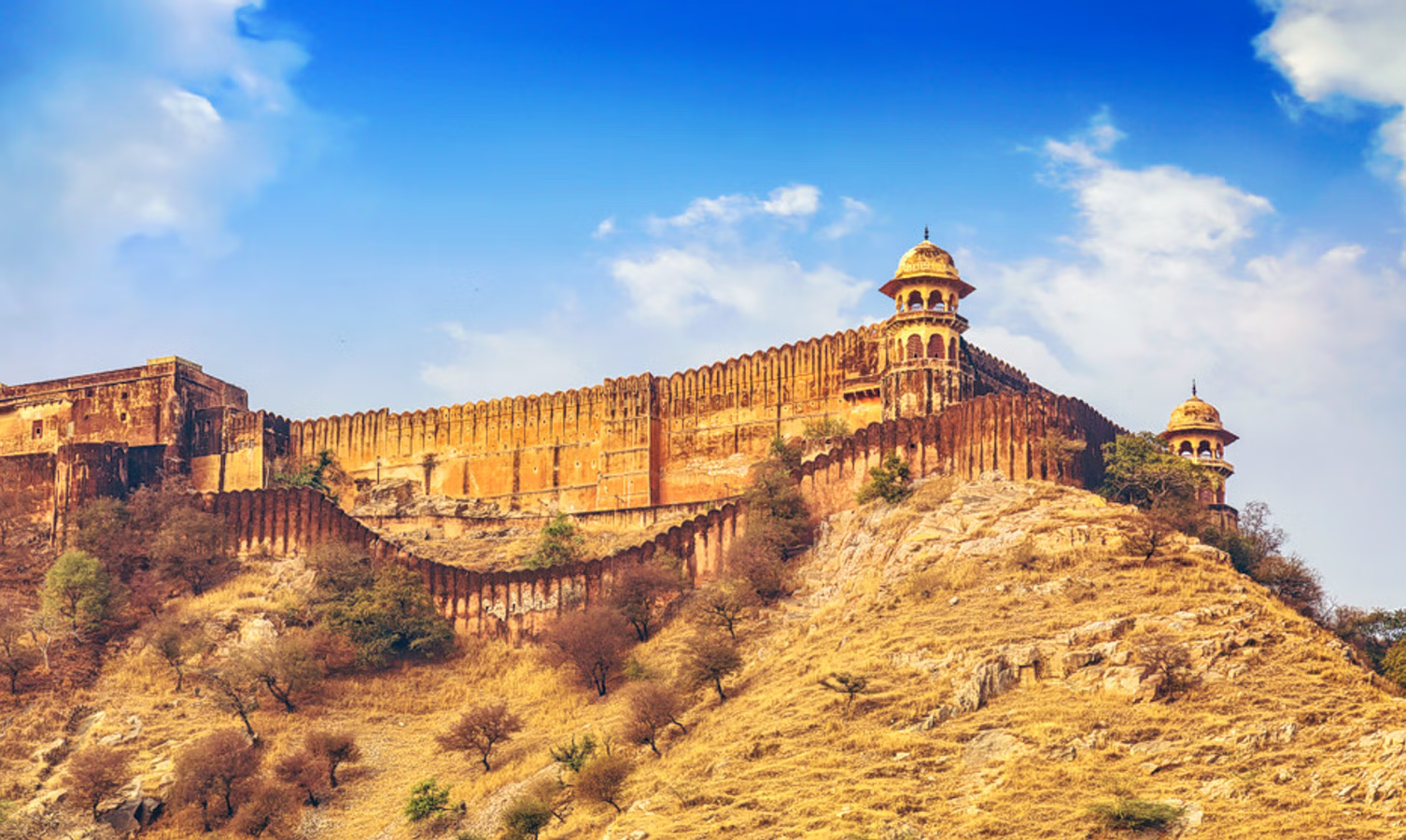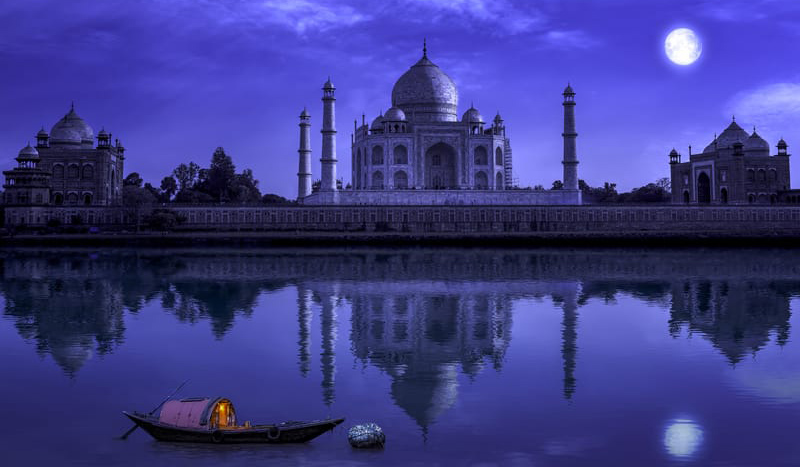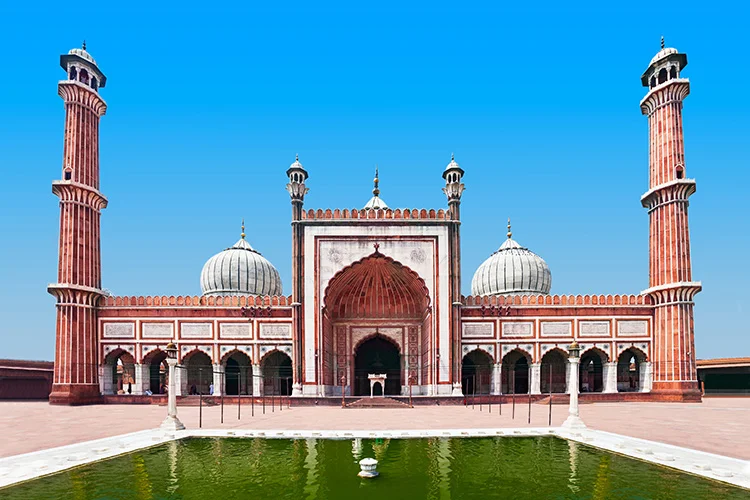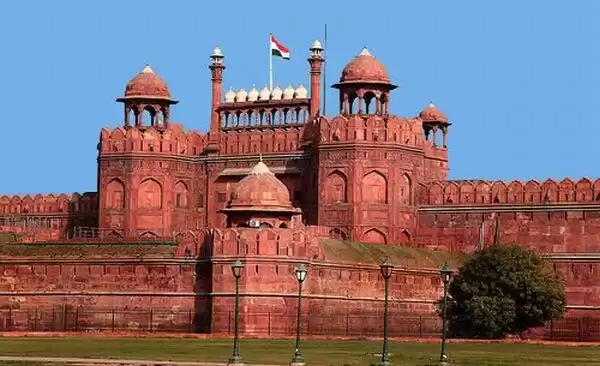Overview
TriûÀngulo
de Oro en Media Pensiû°n
ã´ Golden
Triangle Tour: Discover the Heart of India ã´
India's Golden Triangle is
one of the most celebrated travel circuits, connecting the culturally rich
cities of Delhi, Agra, and Jaipur. Forming a triangular route
on the map, this tour offers a perfect introduction to India's fascinating
history, architectural grandeur, and vibrant local life making it especially
popular among first-time visitors.
Delhi
Where History Meets Modernity
The national capital, Delhi, is
a captivating blend of the ancient and the contemporary. Walk through centuries
of history at landmarks like the Red Fort, Qutub Minar, and Humayun's
Tomb. Experience the chaotic charm of Chandni Chowks bustling
bazaars and Savor the city's diverse street food.
Agra
The City of Eternal Love
Agra is home to the Taj
Mahal, the world-renowned symbol of love and one of the Seven
Wonders of the World. This city also features the impressive Agra
Fort and the historical town of Fatehpur Sikri, offering
a deep dive into the Mughal legacy.
Jaipur
The Pink City of Royalty
Known for its striking pink-hued
architecture, Jaipur invites you into a world of majestic forts and
palaces. Highlights include the Amber Fort, Hawa Mahal, and
the vibrant local markets filled with traditional crafts, jewellery,
and textiles.Travel
Options
The Golden Triangle can be
explored by road, train, or flights, with flexible routes in
both clockwise and counter-clockwise directions.
Best
Time to Visit
The ideal time to experience the
Golden Triangle is during the winter months (October to March) when
the weather is pleasant, making sightseeing comfortable.
ã ÿ¡ Important Note on Departure Dates
Please note that
the Taj Mahal is closed every Friday.
As per the itinerary, the Taj Mahal visit
is scheduled on Day 6. Therefore, to ensure smooth execution of the
tour without missing this iconic monument, the following departure dates are restricted:
ã
Restricted Departure Dates:
Kindly plan your trip accordingly to avoid disappointment.
Itinerary
TriûÀngulo de Oroô = Golden Triangle (Delhi, Agra, Jaipur)
Media Pensiû°n = Half Board (usually includes breakfast and dinner)
ô Day 1:
Arrival in Delhi
- Airport pickup and transfer to hotel
- Evening at leisure or optional drive past India Gate and Parliament
- Overnight in Delhi
ô Day 2:
Delhi Sightseeing
- Visit Jama Masjid, Raj Ghat, Qutub Minar, Humayunãs Tomb, and Lotus
Temple
- Drive past India Gate, President's House, and Connaught Place
- Overnight in Delhi
ô Day 3:
Delhi ã Jaipur (260 km / 5 hrs)
- Drive to Jaipur, the ãPink Cityã
- Evening free or visit local markets and try Rajasthani cuisine
- Overnight in Jaipur
ô Day 4:
Jaipur Sightseeing
- Visit Amber Fort (elephant/jeep ride), City Palace, Jantar Mantar,
and Hawa Mahal
- Optional: Cultural dinner with folk performance
- Overnight in Jaipur
ô Day 5:
Jaipur ã Agra via Fatehpur Sikri (240 km / 5 hrs)
- En route visit Fatehpur Sikri, a UNESCO World Heritage site
- Evening free for sunset view of Taj Mahal from Mehtab Bagh
- Overnight in Agra
ô Day 6:
Agra Sightseeing
- Sunrise visit to the Taj Mahal (closed on Fridays)
- Visit Agra Fort and explore local marble workshops
- Overnight in Agra
ô Day 7:
Agra ã Delhi Departure (210 km / 4 hrs)
- Drive back to Delhi and transfer to airport/hotel
- Tour ends with unforgettable memories
ô Enhance Your Journey with Cultural Extensions to Varanasi and Kathmandu
Inclusions & Exclusions
ã
Tour
Inclusions
- 6 nights hotel accommodation with daily breakfast
- Private air-conditioned vehicle with driver
- Local English-speaking guides in each city
- Entrance fees to monuments (optional inclusion)
- All tolls, parking, fuel, and taxes
- Airport/train station transfers
- Bottled water during travel
ã Tour
Exclusions
- International airfare & visa fees
- Travel insurance
- Lunches, dinners, personal expenses
- Tips, camera/video charges at monuments
- Optional activities not mentioned in inclusions
Tour Policy
ô Good to Know (for Foreign Travelers)
-
Indian e-Tourist Visa required (apply online in advance)
-
Modest dress is advised for temples and mosques
-
Best time to visit: October to April for cooler weather
-
Credit cards are widely accepted; carry small cash for local marketsô ô ô ô ô ô ô ô ô ô ô ô ô ô ô ô ô ô ô ô ô ô ô ô ô ô ô ô ô ô ô ô ô ô ô ô ô ô ô ô ô ô ô ô ô ô ô ô ô ô ô ô ô ô ô ô ô ô ô ô ô ô ô ô ô ô ô ô ô ô ô ô ô ô ô ô ô ô ô ô ô ô ô ô ô ô ô ô ô ô ô ô ô ô ô ô ô ô ô ô ô ô ô ô ô ô ô ô ô ô ô ô ô ô ô ô ô ô ô ô ô ô ô ô ô E-Visa Information HISPANO INDIA TRAVELS
Entering India by air or land is relatively straightforward, with standard immigration and customs procedures. A previously frustrating law barring re-entry into India within two months of the previous date of departure has been done away with (except for citizens of some Asian countries), thus allowing most travelers to combine their India tour with side trips to neighboring countries.
ô PASSPORTS
To enter India you need a valid passport and an onward/return ticket, and a visa. Note that your passport needs to be valid for at least 180 days after your entry into India, and should have at least two blank pages. If your passport is lost or stolen, immediately contact your countryãs representative. Keep digital photos or photocopies of your airline ticket and the identity and visa pages of your passport in case of emergency.
VISA
Required for most visitors; e-Visa (valid 60 days) available for more than 150 nationalities. Longer trips require a standard six-month tourist visa.
ô FURTHER INFORMATION
Apart from citizens of Nepal, Bhutan and the Maldives, who don't need visas for India unless they are arriving from mainland China, and citizens of Japan and South Korea, who can obtain a visa on arrival, everyone needs to apply for a visa before arriving in India. However, more than 150 nationalities can obtain the wonderfully hassle-free 60-dayô e-Visa.
There's also a six-month tourist visa, which is valid from the date of issue, not the date of arrival in India.
ô E-VISA
ôñô ô Citizens from more than 150 countries can apply for an e-Visa (www.indianvisaonline.gov.in/evisa).
ôñô ô You must apply a minimum of four days and a maximum of 120 days before you are due to arrive in India.
ôñô ô The visa will be valid from your date of arrival in India.
ôñô ô It's a double-entry visa that lasts for 60 days from your first date of entry.
ôñô ô To apply, upload a photograph as well as a copy of your passport; have at least 180 days' validity in your passport and at least two blank pages.
ôñô ô If your application is approved, you will receive an attachment to an email within 72 hours (though normally much sooner), which you'll need to print out and take with you to the airport. You'll then have the e-Visa stamped into your passport on arrival in India.
ôñô ô Note that the e-Visa is also sometimes referred to as a 'visa on arrival', though you need to apply for it before you arrive.
ôñô ô E-Visas are only valid for entry through 26 designated airports: Ahmedabad, Amritsar, Bag Dogra, Bengaluru (Bangalore), Chennai, Chandigarh, Coimbatore, Delhi, Gaya, Goa, Guwahati, Hyderabad, Jaipur, Kochi (Cochin), Kolkata, Kozhikode (Calicut), Lucknow, Madurai, Mangalore (Mangalore), Mumbai, Nagpur, Pune, Trichy (Tiruchirappalli), Thiruvananthapuram (Trivandrum), Varanasi and Visakhapatnam.
ôñô ô They are also valid for arrival at five designated seaports: Kochi, Goa, Mangalore, Mumbai and Chennai.
ôñô ô E-Visa holders can, however, leave India from any authorized immigration checkpoint.
ENTRY REQUIREMENTSVisas are available at Indian missions worldwide, though in many countries applications are processed by a separate private company.
ôñô ô Student and business visas have strict conditions (consult your Indian embassy for details).
ôñô ô A standard 180-day tourist visa permits multiple entry for most nationalities.
ôñô ô The 60-day e-Visa is usually a double-entry visa.
ôñô ô Five- and 10-year tourist visas are available to US citizensô only underô a bilateral arrangement; however, you can still only stay in the country for up to 180 days continuously.
ôñô ô Currently you are required to submit two digital photographs with your visa application (format jpeg 10kbã300kb), though only one for the e-Visa.
ôñô ô An onward-travel ticket is a requirement for some visas, but this isnãt always enforced (check in advance).
ôñô ô Visas are priced in the local currency and may have an added service fee.
ôñô ô Extended visas are possible for those of Indian origin (excluding those in Pakistan and Bangladesh) who hold a non-Indian passport and live abroad.
ôñô ô If you need to register your visa (for stays of more than 180 days), or need a visa extension (only granted in exceptional cases) or a replacement for a lost passport (required before you can leave the country), then you should apply online atô https://indianfrro.gov.in/eservices/home.jsp.
ôñô ô If you need to see someone in person about your visa issue, then you should do so at theô Foreignersã Regional Registration Officeô in Delhi.
ôñô ô Check with the Indian embassy in your home country for any special conditions that may exist for your nationality.
ô RE-ENTRY REQUIREMENTS
The previous rule of no re-entry on the same visa for two months after leaving India no longer applies to foreign nationals (except nationals of Afghanistan, China, Iran, Pakistan, Iraq, Sudan and Bangladesh, foreigners of Pakistani and Bangladeshi origin, and stateless persons). E-Visas can now be used for double entry into India.
ô VISA EXTENSION
India is extremely stringent with visa extensions. At the time of writing, the government was granting extensions only in circumstances such as medical emergencies or theft of passport just before the applicant planned to leave the country (at the end of their visa).
If you do need to extend your visa due to any such exigency, you should first apply online at e-FRRO (https://indianfrro.gov.in/eservices/home.jsp), which also deals with replacements for lost/stolen passports (required before you can leave the country). If you need to see someone in person, or are called in for an interview, the place to go is theô Foreignersã Regional Registration Officeô in Delhi. There are also some regional FRROs, but these are even less likely to grant an extension.
Assuming you meet the stringent criteria, the FRRO is permitted to issue an extension of 14 days (free for nationals of most countries; enquire on application). You must bring one passport photo (take more, just in case), your passport (or emergency travel document, if your passport is missing), and a letter from the hospital where you're having treatment if it's a medical emergency. Note that this system is designed to get you out of the country promptly with the correct official stamps, not to give you two extra weeks of travel and leisure.
ô TRAVEL PERMITS
Access to certain parts of India ã particularly disputed border areas ã is controlled by a system of permits that applies mostly to foreigners but also to Indian citizens in some areas.
Permits are required to visit Arunachal Pradesh, Sikkim and certain parts of Himachal Pradesh, Ladakh and Uttarakhand that lie close to the disputed border with China/Tibet. A permit is also necessary for travel to the Lakshadweep Islands and to some parts of the Andaman Islands.
In Odisha, permission is no longer required to visit tribal regions, and thereãs nothing to stop tourists from taking a bus or taxi to visit regional markets, but some villages are off limits to visitors (due to potential Maoist activity), so seek local advice before setting out.
Obtaining a permit is usually a formality, but travel agents must apply on your behalf for certain areas, including many trekking routes passing close to national borders.ô
